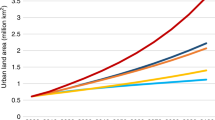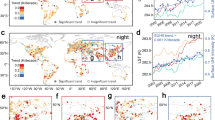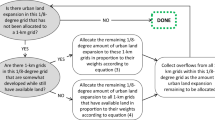Abstract
High-resolution global maps of annual urban land coverage provide fundamental information of global environmental change and contribute to applications related to climate mitigation and urban planning for sustainable development. Here we map global annual urban dynamics from 1985 to 2015 at a 30 m resolution using numerous surface reflectance data from Landsat satellites. We find that global urban extent has expanded by 9,687 km2 per year. This rate is four times greater than previous reputable estimates from worldwide individual cities, suggesting an unprecedented rate of global urbanization. The rate of urban expansion is notably faster than that of population growth, indicating that the urban land area already exceeds what is needed to sustain population growth. Looking ahead, using these maps in conjunction with integrated assessment models can facilitate greater understanding of the complex environmental impacts of urbanization and help urban planners avoid natural hazards; for example, by limiting new development in flood risk zones.
This is a preview of subscription content, access via your institution
Access options
Access Nature and 54 other Nature Portfolio journals
Get Nature+, our best-value online-access subscription
$29.99 / 30 days
cancel any time
Subscribe to this journal
Receive 12 digital issues and online access to articles
$119.00 per year
only $9.92 per issue
Buy this article
- Purchase on Springer Link
- Instant access to full article PDF
Prices may be subject to local taxes which are calculated during checkout




Similar content being viewed by others
Data availability
Satellite-derived high-resolution global urban maps from 1985 to 2015, the validation samples used in this study, are freely available at https://doi.org/10.6084/m9.figshare.11513178.v1. Other ancillary datasets are available on request from X. Liu (liuxp3@mail.sysu.edu.cn).
Code availability
The script used for preprocessing the Landsat time series data in GEE (a cloud-based computational platform) is freely available at https://doi.org/10.6084/m9.figshare.11513178.v1. Analysis scripts are available on request from X. Liu (liuxp3@mail.sysu.edu.cn).
References
IPCC Special Report on Climate Change, Desertification, Land Degradation, Sustainable Land Management, Food Security, and Greenhouse Gas Fluxes in Terrestrial Ecosystems (SR2) (WPO and UNEP, 2017).
Seto, K. C. et al. in Climate Change 2014: Mitigation of Climate Change (eds Edenhofer, O. et al.) 927–1000 (Cambridge Univ. Press, 2014).
World Urbanization Prospects: The 2018 Revision (UN, 2019).
Sexton, J. O. et al. Urban growth of the Washington, D.C.–Baltimore, MD metropolitan region from 1984 to 2010 by annual, Landsat-based estimates of impervious cover. Remote Sens. Environ. 129, 42–53 (2013).
Seto, K. C. et al. Urban land teleconnections and sustainability. Proc. Natl Acad. Sci. USA 109, 7687–7692 (2012).
Pesaresi, M. et al. GHS Built-up Grid, Derived from Landsat, Multitemporal (1975, 1990, 2000, 2014) (European Commission, 2015).
Liu, X. et al. High-resolution multi-temporal mapping of global urban land using Landsat images based on the Google Earth Engine Platform. Remote Sens. Environ. 209, 227–239 (2018).
Hansen, M. C. et al. High-resolution global maps of 21st-century forest cover change. Science 342, 850–853 (2013).
Zhou, L. et al. Evidence for a significant urbanization effect on climate in China. Proc. Natl Acad. Sci. USA 101, 9540–9544 (2004).
IPCC Climate Change 2013: The Physical Science Basis (eds Stocker, T. F. et al.) (Cambridge Univ. Press, 2013).
Kiswanto, Tsuyuki, S., Mardiany & Sumaryono. Completing yearly land cover maps for accurately describing annual changes of tropical landscapes. Glob. Ecol. Conserv. 13, e00384 (2018)..
Foley, J. A. et al. Global consequences of land use. Science 309, 570–574 (2005).
Stokes, E. C. & Seto, K. Characterizing and measuring urban landscapes for sustainability. Environ. Res. Lett. 14, 045002 (2018).
Zhang, W., Villarini, G., Vecchi, G. A. & Smith, J. A. Urbanization exacerbated the rainfall and flooding caused by hurricane Harvey in Houston. Nature 563, 384–388 (2018).
Reducing Disaster Risk by Managing Urban Land Use: Guidance Notes for Planners (Asian Development Bank, 2016).
Gong, P. et al. Annual maps of global artificial impervious area (GAIA) between 1985 and 2018. Remote Sens. Environ. 236, 111510 (2020).
Zhou, Y., Li, X., Asrar, G. R., Smith, S. J. & Imhoff, M. A global record of annual urban dynamics (1992–2013) from nighttime lights. Remote Sens. Environ. 219, 206–220 (2018).
Seto, K. C., Fragkias, M., Güneralp, B. & Reilly, M. K. A meta-analysis of global urban land expansion. PloS ONE 6, e23777 (2011).
Pesaresi, M. et al. A global human settlement layer from optical HR/VHR RS data: concept and first results. IEEE J Sel. Top. Appl. Earth Obs. Remote Sens. 6, 2102–2131 (2013).
Esch, T. et al. Urban footprint processor—Fully automated processing chain generating settlement masks from global data of the TanDEM-X mission. IEEE Geosci. Remote Sens. Lett. 10, 1617–1621 (2013).
Riahi, K. et al. The Shared Socioeconomic Pathways and their energy, land use, and greenhouse gas emissions implications: an overview. Glob. Environ. Change 42, 153–168 (2017).
Taubenböck, H. et al. A new ranking of the world’s largest cities—do administrative units obscure morphological realities? Remote Sens. Environ. 232, 111353 (2019).
Homer, C. G. et al. Completion of the 2011 National Land Cover Database for the conterminous United States-Representing a decade of land cover change information. Photogramm. Eng. Remote Sens. 81, 345–354 (2015).
Seto, K. C. & Ramankutty, N. Hidden linkages between urbanization and food systems. Science 352, 943–945 (2016).
McDonald, R. I. et al. Water on an urban planet: urbanization and the reach of urban water infrastructure. Glob. Environ. Change 27, 96–105 (2014).
Fu, Y. C. et al. Characterizing the spatial pattern of annual urban growth by using time series Landsat imagery. Sci. Total Environ. 666, 274–284 (2019).
d’Amour, C. B. et al. Future urban land expansion and implications for global croplands. Proc. Natl Acad. Sci. USA 114, 8939–8944 (2017).
Wu, Y., Shan, L., Guo, Z. & Peng, Y. Cultivated land protection policies in China facing 2030: dynamic balance system versus basic farmland zoning. Habitat Int. 69, 126–138 (2017).
Stokes, E. C. & Seto, K. C. Principles for minimizing global land impacts of urbanization. Technol. Archit. Des. 3, 5–10 (2019).
Nangini, C. et al. A global dataset of CO2 emissions and ancillary data related to emissions for 343 cities. Sci. Data 6, 180280 (2019).
Xi, F. et al. Substantial global carbon uptake by cement carbonation. Nat. Geosci. 9, 880–883 (2016).
Zhang, G. J., Cai, M. & Hu, A. Energy consumption and the unexplained winter warming over northern Asia and North America. Nat. Clim. Change 3, 466–470 (2013).
Li, X. et al. A dataset of 30-meter annual vegetation phenology indicators (1985–2015) in urban areas of the conterminous United States. Earth Syst. Sci. Data 12, 357–371 (2019).
Doxsey-Whitfield, E. et al. Taking advantage of the improved availability of census data: a first look at the gridded population of the world, version 4. Pap. Appl. Geogr. 1, 226–234 (2015).
Bontemps, S. et al. Consistent global land cover maps for climate modelling communities: current achievements of the ESA’s land cover CCI. In Proc. ESA Living Planet Symposium 9–13 (ESA, 2013).
Acknowledgements
This research was funded by the National Key R&D Program of China (grant no. 2017YFA0604404 and grant no. 2019YFA0607203). Z.Z. was supported by the start-up fund provided by Southern University of Science and Technology (grant no. G02296001). We thank the French ANR Convergence Institute CLAND project for support. We thank many students (for example, Z. Lin) for their days and nights validating our GAUD product via high-resolution satellite image interpretation. We also thank K. C. Seto and M. Hansen for their constructive comments on this paper.
Author information
Authors and Affiliations
Contributions
X. Liu, Xia Li and Z.Z. designed the research; Y.H. and X.X. performed analysis; X. Liu, Xuecao Li and Z.Z. wrote the draft; and all the authors contributed to the interpretation of the results and the writing of the paper.
Corresponding authors
Ethics declarations
Competing interests
The authors declare no competing interests.
Additional information
Publisher’s note Springer Nature remains neutral with regard to jurisdictional claims in published maps and institutional affiliations.
Extended data
Extended Data Fig. 1 The box-plot of the kappa coefficient for fifteen urban ecoregions in 1985 (a) and 2015 (b).
GHSL: global human settlement layer; GAIA: Global Artificial Impervious Areas; GUL: global urban land; GUF: global urban footprint; GAUD: global annual urban dynamics. Note: kappa with negative value suggests the urban product has notable overestimation or underestimation in particular ecoregions.
Extended Data Fig. 2 Overall accuracy of mapped urban land expansion years during periods of 1985–2000 and 2000–2015.
Cities used for validation were randomly selected globally with different sizes, biomes, and climate zones.
Extended Data Fig. 3 Detected urban land expansion years compared with the Landsat-derived time series data for six representative cities.
a, Shanghai (China), b, Chicago (USA), c, Tianjin (China), d, Paris (France), e, Moscow (Russia), and f, Bangkok (Thailand).
Extended Data Fig. 4 Detected green recovery years compared to the Landsat derived time series data for four representative cities.
a, Beijing (China), b, New York (USA), c, Tokyo (Japan), d, Baltimore (USA).
Extended Data Fig. 5 Comparison of growth rates between urban extent and population.
Left: ratio of growth rates between urban area and population. Right: scatter plot of total growth rate versus urban growth rate for each country.
Extended Data Fig. 6 Trend of urban expansion in China, India, and USA regarding the normalized urban area relative to 2015.
Grey lines represent each urban cluster while colored lines represent China, India or the USA.
Supplementary information
Supplementary Information
Supplementary Methods 1–3, Figs. 1–15 and Tables 1 and 2.
Rights and permissions
About this article
Cite this article
Liu, X., Huang, Y., Xu, X. et al. High-spatiotemporal-resolution mapping of global urban change from 1985 to 2015. Nat Sustain 3, 564–570 (2020). https://doi.org/10.1038/s41893-020-0521-x
Received:
Accepted:
Published:
Issue Date:
DOI: https://doi.org/10.1038/s41893-020-0521-x
This article is cited by
-
Defining a city — delineating urban areas using cell-phone data
Nature Cities (2024)
-
Analyzing urban influence on extreme winter precipitation through observations and numerical simulation of two South China case studies
Scientific Reports (2024)
-
Ecosystem services potential is declining across European capital metropolitan areas
Scientific Reports (2024)
-
Dynamic urban land extensification is projected to lead to imbalances in the global land-carbon equilibrium
Communications Earth & Environment (2024)
-
Global distribution of surface soil organic carbon in urban greenspaces
Nature Communications (2024)



